Pork and Cuy: Street Food in Cuenca Ecuador
Shortly after your arrival in Cuenca, you’ll realize that there are some pretty unique things here. One of the things tourists and expats enjoy seeing (and eating) is street food. In this post, you’ll learn about pork and cuy in Cuenca.
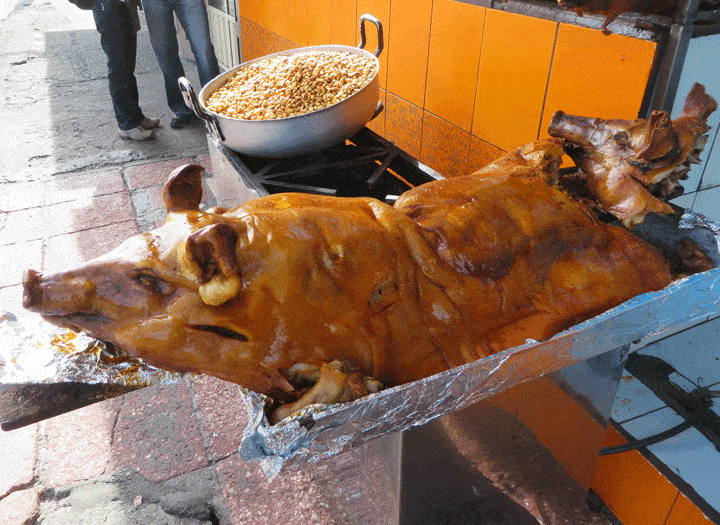
Pork and Cuy: Street Food in Cuenca Ecuador
There are a number of different things sold as street food in Cuenca, like salchipapas (french fries with a sausage/wiener on top,) bags of fruit or coconut slices, and the pastel-colored meringue with sprinkles on top.
But when it comes to street food two items rise above all others as attention grabbers: the pork and cuy.
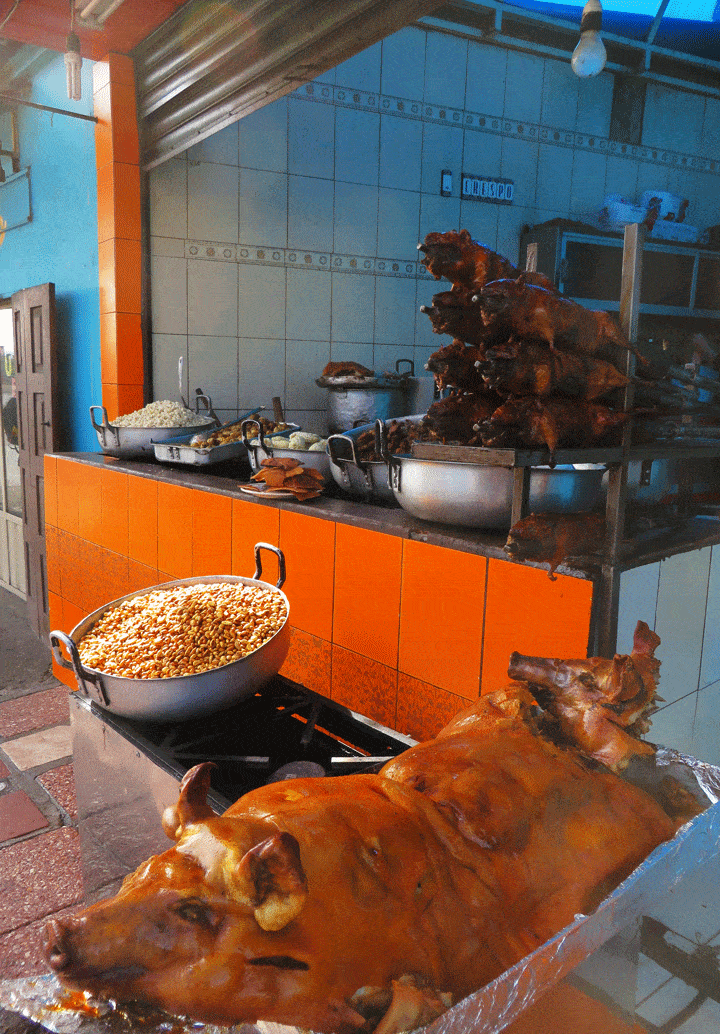
Freshly Roasted Cuy on a Stick
For example, you may wonder what the small chicken-sized animal is – on a stick – roasting over a grill. It is known locally as “cuy”. It is what we know as guinea pig, and it is the local delicacy. It is eaten on special occasions and is one of the pricier meals here.
Loved by some, and held in disdain by others, the cuy is roasted whole over an open grill.
The cuy industry here is quite large, and in the surrounding countryside, you’ll see large fields of alfalfa – the food of choice for cuy farms. At the open markets, you can purchase them live, cleaned or roasted. Your choice.
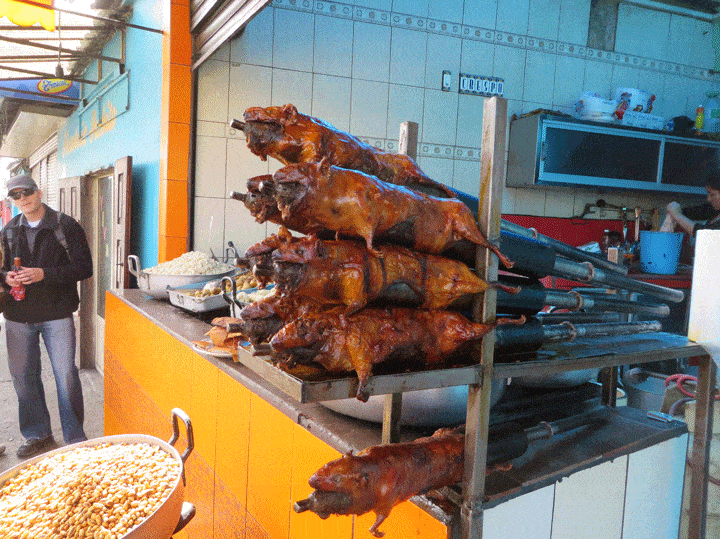
Avenida Don Bosco is a good place to see the pork and cuy for sale, that’s where the pictures for this post were taken.
This food stand smells amazing. They sell some yummy-looking side dishes to go along with the rich meat.
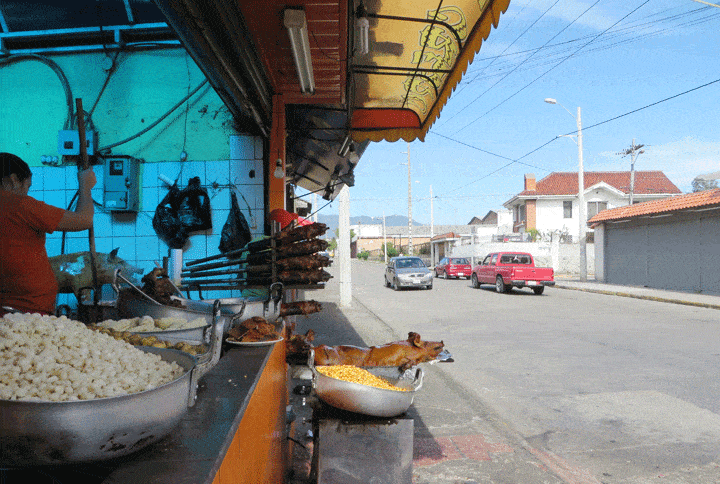
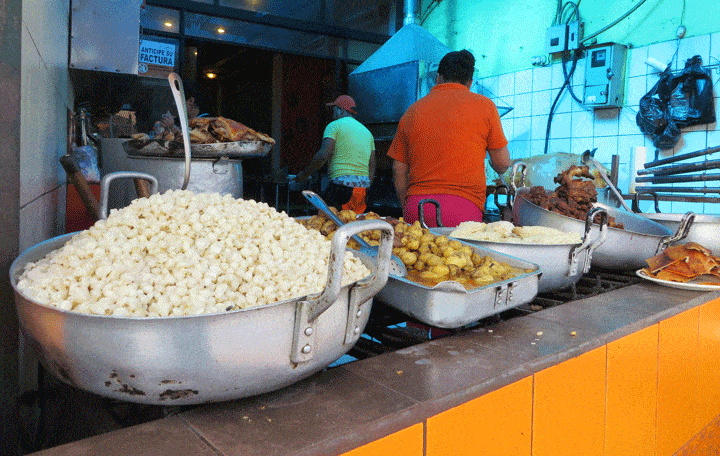
We have tried the cuy and it was good. We haven’t tried the pork yet but it smells amazing!
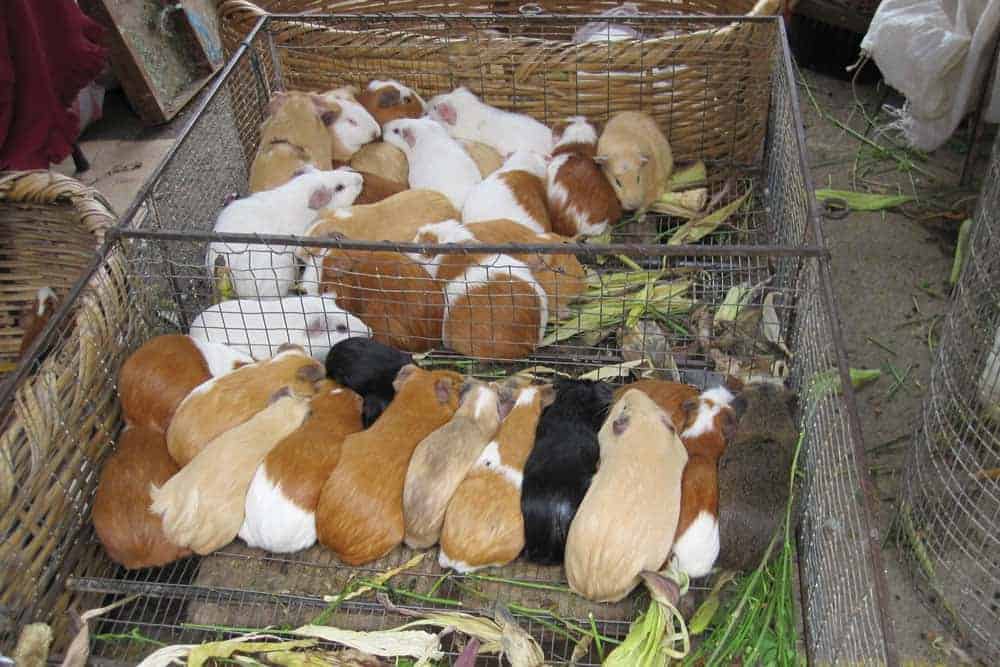
Whole (Raw) Pork
Another unique feature here in Cuenca, is the roasted pig – you’ve probably never seen pork like this before. A stroll down a main road will provide many opportunities to sample the numerous ways to cook pork.
The pork at the food stands looks cooked but it isn’t. Usually, the skin is browned up with a blowtorch to remove the hair and then rubbed in oil or butter and browned up again.
As customers come by the vendor will cut off the slice they want and cook it for them at the food stand or give it to them to cook at home.

Normally the pig is prepared the way shown in these photos but we have seen the pork prepared differently. Sometimes the pig is stretched out on a large grill. The grill is rotated above a huge BBQ until the meat is fully cooked.
First, the whole pork is torched (with a blowtorch), to burn off the hair, and roast the skin. Then the body is scraped, to remove the layer of black ash. Then it is rubbed in butter, to give an amazing aroma.
Then, throughout the day, the pig is slowly butchered and cooked for passersby. It is deep-fried (in pork fat, no less), pan-fried, grilled, and cooked in just about any other way you can imagine.
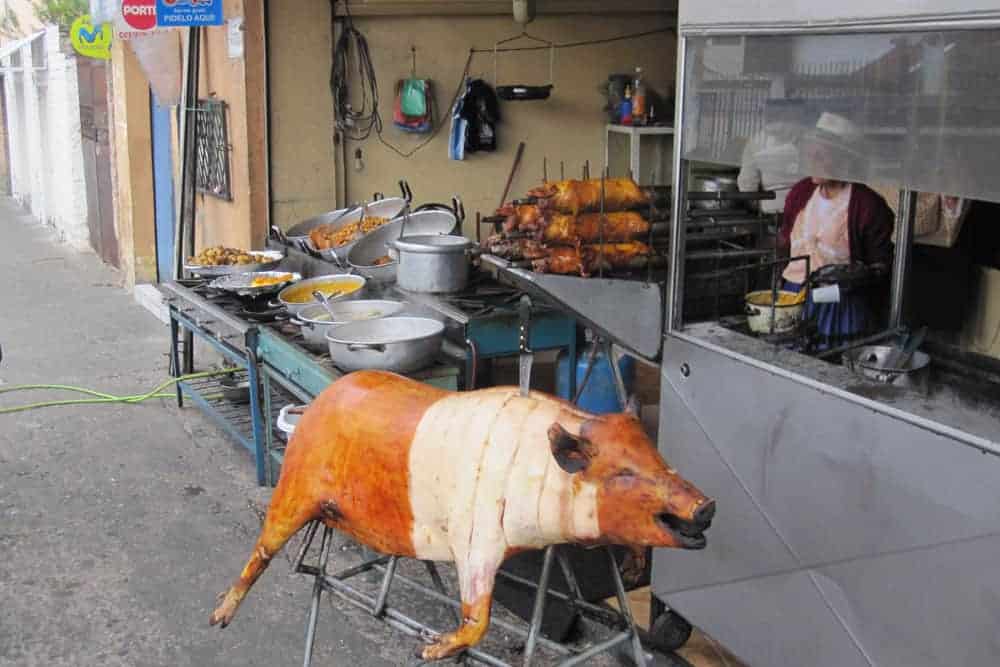
Like eating? Then you’ll love our guide to Ecuadorian food.
You will want to get some advice from locals about safe places to try this – not all street food is safe. However, after boiling in hot oil for a few hours, one could imagine that any bacteria that were present should be long dead.
Have you tried the pork or cuy? What did you think of it? Please share your thoughts by commenting on this post.
You might also enjoy learning about Filipino food – they have a number of pork dishes that are similar to Ecuador’s fried pork.



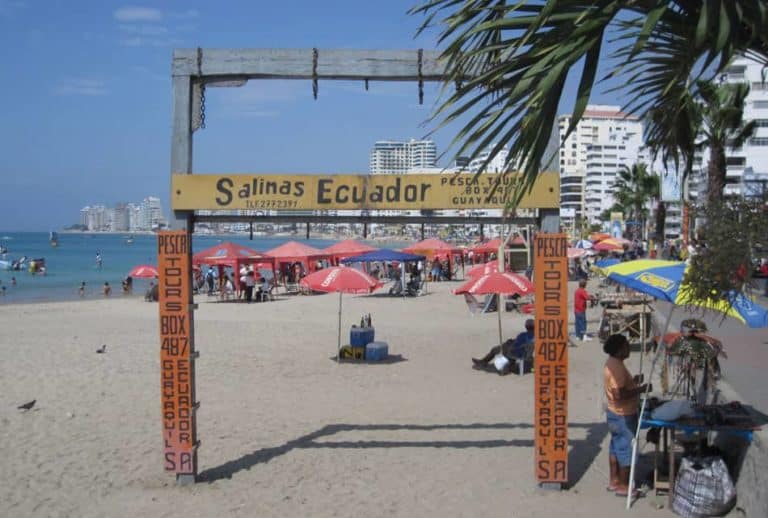



Is beef available in markets to cook at home.
Yes – at the markets and supermarkets.
I didn’t know the name “cuy” when I was in Ecuador (Chimborazo province). I only found out about it when I returned home but needless to say I was surprised when I saw guinea pigs on a spit on the roadside as a sort of street meat.
I didn’t work up the nerve to try it but from articles like yours and others, it sounds like it’s quite the delicacy. Thanks for sharing!
As most of us were born and lived in Cuenca, we want to clarify the article. Basically there are three different ways of preparing pork. One way to prepare it is to burn the whole pork either with a blow torch or with a bunch of eucalyptus branches which have been set on fire; this gives the pig skin a delicious taste. The rest of the meat is prepared in different ways, such as “chicharrón” (meat ) fried in its own fat for a long time. The other parts are baked, fried or cooked in several ways. Another way is called “puerco hornado” which means backed pork. The pictures in the article are of backed pork. This kind of pork is backed and very well cooked. Finally, we have the “puerco a la barcosa”, roasted on a barbecue pit turning it continuously for many hours. Consequently, this pork is also very well cooked. We think that there is no risk to eat pork in Cuenca or any other place in Ecuador.
Typographical errors
Thanks for your comment. It’s great to have this added detail!
Hey Guys if you look for clean and well served traditional food in Cuenca this is the place: https://www.tripadvisor.co/Restaurant_Review-g294309-d4228440-Reviews-The_Mills_of_the_Batan-Cuenca_Azuay_Province.html
Last November we had roasted pig at road side stands in both Quito and Cuenca. The food in both places was wonderful and the people were very friendly. At the time we did not think about trichinosis as we were having such a good time. However, in each case the pig appeared to be fully cooked and we were eating slices cut directly from the body.
I had a meal with both. The roasted pig…tasted just like the Spahnferkel I have had more than once. Enjoyable!
The cuy I enjoyed at one of the local restaurants. The owner took us to the back yard where the employees were cleaning them and putting them all on the coals. A great evening dinner with great service and company. I’ll eat both again for sure!:)
Has anybody heard of trichinosis? It is a larvae from a roundworm that can be transmitted to humans from undercooked pork. Do your research on the internet before you start snacking on Ecuador’s street food. I’m not trying to be negative here, but working for years in the medical field, can tell you that these parasites are nasty and not to be taken lightly. I eat pork myself but make sure it is well- cooked.
That’s a good point. While the pork sold at these stands are often deep fried in pork fat, we’ve noticed that some places will put raw meat in with the cooked and then immediately serve the cooked meat to a customer.
We eat pork here, but we do the same as you – we always make sure it is very well cooked. We generally only eat pork at home.
I made a point of trying both the roast pig and the Cuy while visiting Cuenca last November. Both tasted wonderful. The pig kind of reminded me of Hawaiian Kalua pig and the Cuy was just plain tasty. Getting to try both of those is, to me, what makes travel so interesting. “When in Rome…..”.
This singed and seared piglet does NOT look yummy to me as it evokes the slaughter of the piglet baby. Actually horrifying. It may be hypocritical but being brought up a meat eater I do have cravings for it and enjoy a nice pork chop as much as the next person, but at the same time love animals and prefer not to see the carcass of the animal whose meat I am engorging., thank you very much! Never understood why folks find viewing the entire body of the pig whose flesh they are about to chew upon. Something still primitive and cave man like, I suspect, in the human make-up. Same goes for fish with its head still intact sitting on one’s plate! Are you going to eat its head and those fishy dead eyes? Thanks for letting me put in my two cents worth.
Although I do not eat pork or have no desire to eat guinea pig, I do recognize that people need to know where their food comes from. In the states, people are very disconnected from their food and go to the store to buy their pork chops or whatever and have no clue what is really is.
I bet if you ask a bunch of people in the states where do pork chops come from, they would say the grocery store. People need to understand and know where their food really comes from and give thanks for that animal that gave it’s life for you to eat. People also need to understand that factory farms (CAFO’s) create toxic food that contains hormones, antibiotics, GMOs, pesticides, herbicides, fungicides, chemical additives, preservatives, flavorings, colorings, lving in their own filth, etc. that causes disease in the person that eats it. That is not normal. These animals in Ecuador were likely raised on a farm with space to roam and eat a natural diet that doesn’t contain all the toxic stuff I mentioned earlier.
We were invited over to a families home in Cuenca, and they prepared a delicious meal of cuy and all the sides. It was wonderful, as was their hospitality. Our family loves Cuenca!
I may try cuy sometime in the future, but right now, I have no desire. If I’m living in Ecuador sometime in the future, I may try it. I was with a group of people that did eat cuy and there seemed very, very little meat on it, but then again, I think it was much smaller than the ones in the picture here.
They look so delicious!
I tried cuy in Cañar. To be honest, it tasted great, fresh from the grill, crispy and juicy in the same time.
I am living in Quito and unfortunately its not that easy (as in Cuenca) to get fresh cuy. I would love to eat it again.